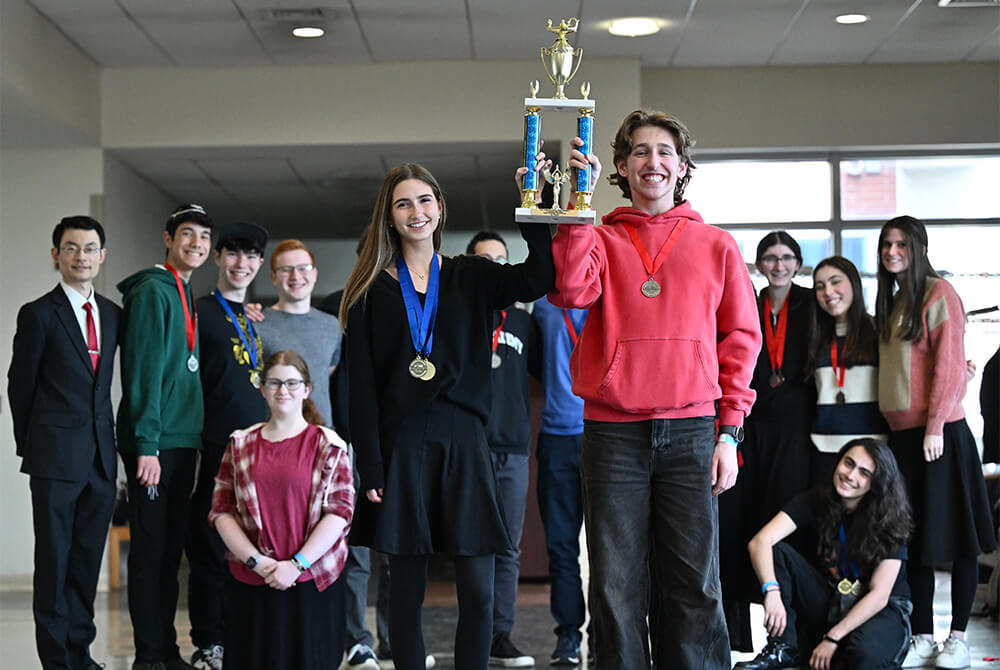Science Olympiad at Touro University Attracts Local Jewish High Schools
SAR Triumphs Once Again at High School STEM Skills Competition

For 12 of the last 15 years, students at Jewish day schools in New York and New Jersey have had the date of The Jewish Education Project Science Olympiad competition, hosted by Touro University’s Lander College, circled on their calendars. It’s easy to see why. After all, what better way is there to match wits with other day school students from across the tristate area, while also hanging out with old friends and meeting new ones?
This year was no exception, as students from 11 New York and New Jersey yeshiva high schools gathered at Lander College this past Sunday to compete in 12 events related to STEM (Science, Technology, Engineering and Math) research. Students from each school participated in at least one event, which tested various aspects of biology, chemistry, anatomy, physiology, earth science, physics, engineering and technology.
“These events were extremely difficult, and they are definitely outside of the range of what you normally learn in class,” said Dr. Ann Shinnar, professor emerita of the Lander College Chemistry Department, who has served as a liaison between Lander College and the event organizers since 2011.
Since 2005, the Science Olympiad for day school students has been organized by Dr. Linda Padwa, of the Institute for STEM Education at Stony Brook University. She saw a need for the Sunday competition when her shomer Shabbat grandchildren were unable to participate in the annual New York state Olympiad because it took place on Saturdays.
Threepeat After Me
For the third straight year, Salanter Akiba Riverdale Academy (SAR) High School finished first, followed by The Frisch School in Paramus, Yeshiva University High School for Girls in Queens, and SKA High School for Girls in Hewlett, respectively.
“Our students get to experience the fun of science, they get to learn and they get to enjoy being on a team, part of a whole group where we support each other and care about each other,” said SAR teacher and Olympiad coach Qiao Feng. “And we get the fun of seeing our students’ happy faces when they achieve something. And when they win!”
A Bug’s Life
One event not for the squeamish was Entomology, in which participants were asked to identify insects by order and family, and to answer questions about insects. Frisch’s coaches assigned juniors Serena Wachsman and Lily Acton to compete in the event, even though neither knew much about the subject at the outset.
“We’d be in school searching pictures of bugs and their anatomy and lifecycles, and our friends would see us and say ‘What are you doing?!’” said Lily. “But it was fun and we learned about a lot of things we wouldn’t have known otherwise.”
Serena agreed, adding that while she’s unsure whether there will be any practical applications to what they studied, “The next time I see an ant, I'll be able to identify the three parts of the body, which is pretty interesting.”
Students Finding Direction
With the advent of Waze and Google Maps and other directional apps and software, students’ experience with maps and other topographic tools is more limited than previous generations. The Road Scholar challenge strives to force them to utilize those dormant skills by requiring teams to respond to questions based on one or more state highway maps, USGS topographic maps or satellite/aerial images.
“I had to do a lot to prepare because it’s something I don't really know what to do with a map because I have my phone,” said Elijah Ritter, a junior at SAR who placed second in the event. “So it was cool to learn how to use maps and also fun because it was something I could talk to my parents about.”
Still Playing the Hits
Even though certain events are rotated in and out of the competition each year, several favorites remained, such as Tower, in which participants constructed a tower out of wood and glue. To test the stability, a bucket was attached to the bottom of the tower and then slowly filled with sand until the bridge inevitably broke. Students earned points according to how much weight their tower could hold, and the fewer materials used, the higher the potential score. Frisch sophomore Jacob Langer came in first with a tower that was able to secure 18 kilograms of sand.
Another is Write-It/Do-It, where a team of two students work in separate rooms. One student views a 3-D display and writes instructions on how to assemble it, and then the teammate reads the description and builds the display in a separate room, all within 50 minutes.
“I used to compete in Forestry, but I switched to Write-it/Do-It,” said Sammy Adler, a junior at DRS Yeshiva High School, “because I’m better being hands-on than remembering stuff.”
Voice of Experience
As part of the closing ceremony, Dr. Shinnar invited Aryeh Krischer, who is currently pursuing his Ph.D. in applied physics at Columbia University and who competed in the Science Olympiad when he was a high school student at Torah Academy of Bergen County (TABC), to address the students. Krischer assisted with the Electric Vehicle challenge, for which teams had to design, build and test a vehicle that used electrical energy as its sole means of propulsion to travel as quickly as possible and stop close to a target point. He told the students that few things will impact their lives like a good teacher.
“Throughout my education, I've been blessed to be surrounded by some fantastic teachers,” he said. “When you find some of your own, stick with them, because when you find amazing teachers who will guide you and be there for you, you will learn far more from these people than you will learn in any classroom.”

